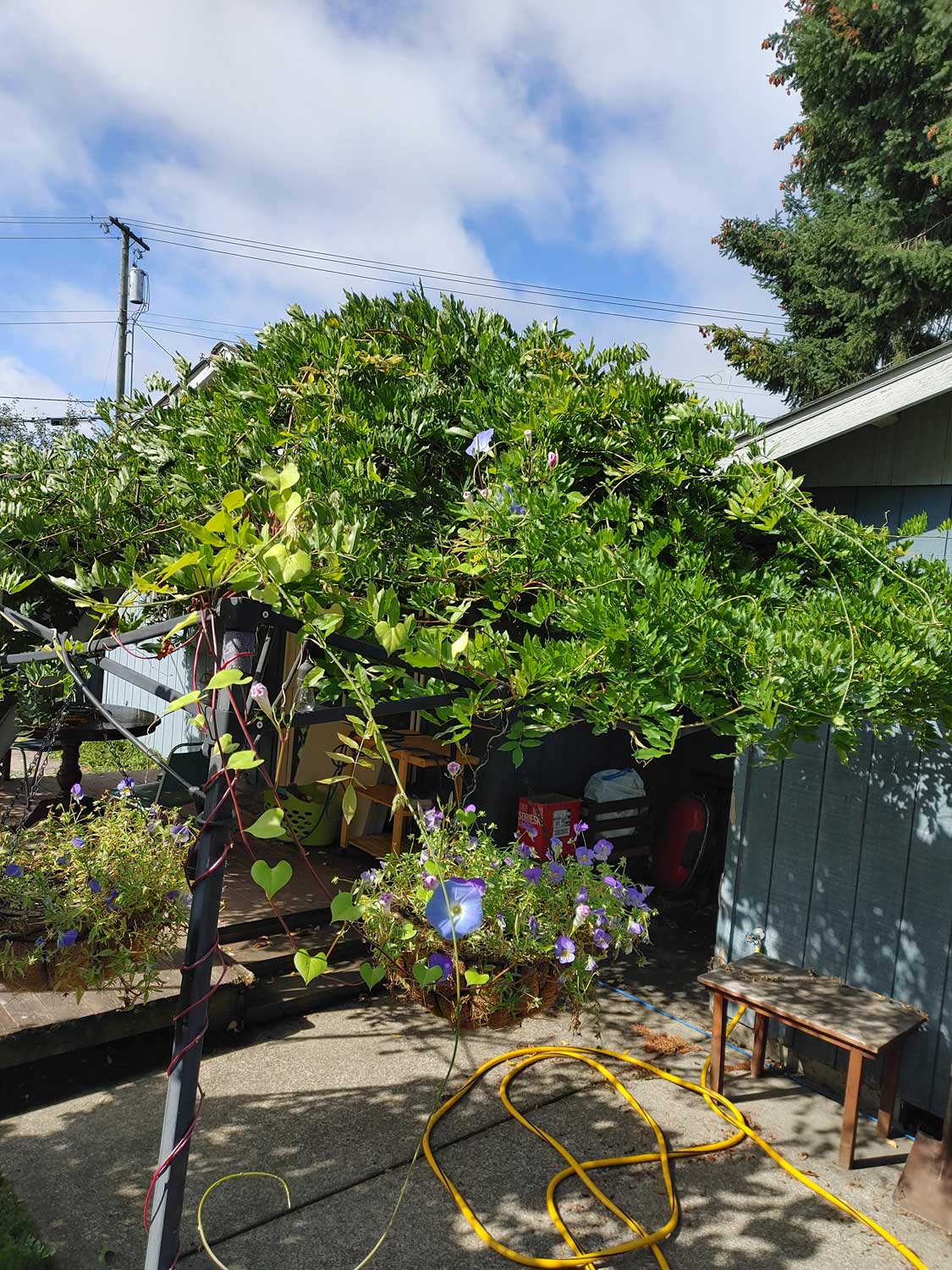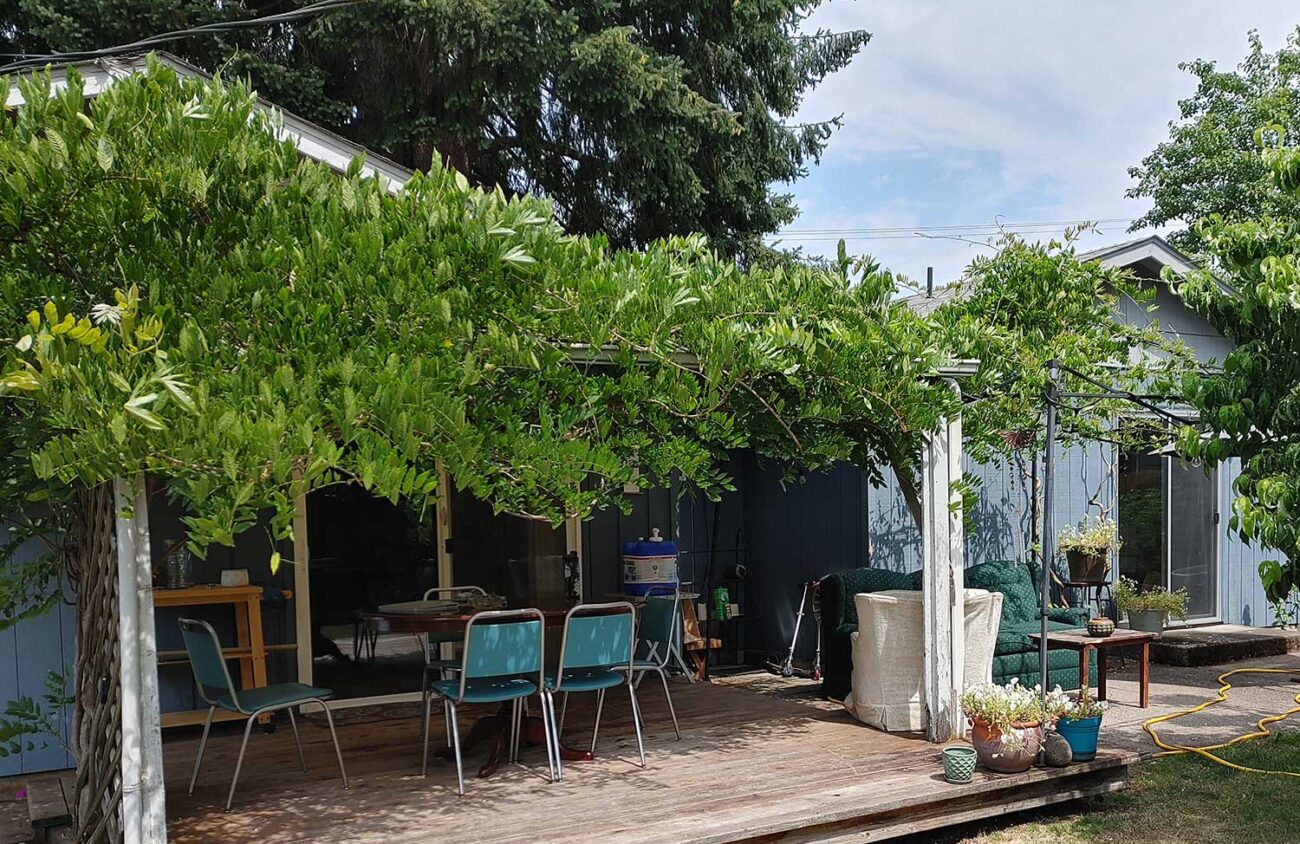Making mistakes is an essential part of life — it’s the best way to learn, but it’s not exactly fun. Especially if it causes ruin to something you set out to nurture, like a garden. Gardening can be complicated, with a multitude of ways to screw it up. Read on to learn from others’ mistakes, gardening “boo-boo” stories and expert advice.
Know Your Plant: The Wandering Wisteria
During the COVID-19 lockdown, Eugene Weekly office manager JJ Snyder decided to nurture new tendrils growing on the cut-back wisteria bush next to her covered back deck. Since the bush had a thick trunk, she assumed the house’s previous occupants had cut the plant to make the yard look neater.
“Every day I would go out and check on the new growth, encouraging it like it was one of my children, and hoping that quarantine would lift soon so that I could share the amazing smell and beautiful flowers with my friends,” she says.
By the fall, the plant had grown 12 feet across the deck. The next spring, there wasn’t room for the wisteria to continue growing on the deck, so Snyder put up an old pop-up frame beside the deck. The plant grew rapidly. New shoots sprang out of the trunk and wove through the older vines. After a few months, Snyder noticed the roof showing signs of stress, but she wasn’t worried, she would just cut back the new growth. Then she got COVID.
For a few weeks Snyder was too sick to tend to the wisteria. When she recovered, she set out to complete the pruning job that she assumed would take 30 minutes. She put on a floppy sun hat, picked up her pruning shears and got to work, but she found the wisteria now covered the entire roof of her back deck. It had wrapped itself around her hanging plants and climbed up the side of the house and into the air vents. She spent hours on a ladder getting the wisteria under control.
“Sunburnt, sweaty and trying not to scratch the concerning rash that was taking over my arms, I stood back and looked at what I had accomplished,” she says. “I swear the plant laughed at me as now I could plainly see that it had grown into a tree. Back on the ladder, with gloves this time, I hacked at it with some choice words.”
When she finished with the side of the house and the deck’s roof, she took to the wisteria’s trunk to cut off new growth, but while kneeling in the dirt, she discovered that the plant had also grown underneath her deck.
“I won’t lie, I cried a little. OK, maybe a lot,” she says. “Maybe I sobbed and questioned whether vining plants were actually the superior species on the planet. Maybe gorgeous flowers were just a ruse to lure us in while they slowly destroyed our structures?”
As the sun set, Snyder finished removing the vines that she had cherished the previous summer. The plastic roof of the deck was cracked, the paint was damaged on the house’s fascia and she spent the rest of the summer removing vines and new runners she found in her yard.
“I learned a great lesson that year; never turn your back to a wisteria plant and always, always research plants that you have growing in your spaces. But damn, do those flowers smell good.”

Know Your Fertilizer: The Shit That Wouldn’t Quit (Growing Weeds)
Andrea Mull, Lane Community College’s Learning Garden specialist, has a background in organic and biodynamic agriculture. One spring, about 25 years ago, Mull started her first large garden in a 50-by-50 square foot plot. She picked up 8 or 10 yards — four to six loads in a pickup truck — of free horse manure mixed with wood shavings from a nearby farm, thinking it would make a good fertilizer for her new garden and save her money.
Not knowing anything about horses, Mull didn’t realize that they aren’t good at digesting weed seeds, leading their poop to hold weeds, and the dewormer that prevents parasites in horses can stay in their poop and harm ground worms if used in a garden.
Mull tried adding leaves, garden amendments and different types of manure, but the tomatoes, eggplants and peppers she planted didn’t grow. After nothing but weeds grew in her garden for three years, Mull learned the importance of using the correct fertilizer — horse manure should be composted before using it, and only use hay from an annual crop in a garden so any seeds that grow from it will die off at the end of the summer or with winter frost.
While many people want to start a garden in the spring because the ground is saturated and wet, the best time to start is actually in fall, Mull says. Digging too soon damages the soil and prevents roots from growing more than a few inches into the ground.
‘Right Plant, Right Place’: Tips From an OSU Master Gardener
Erica Chernoh, horticulture faculty with Oregon State University Extension in Lane County, helps people who call in with garden problems, and helps gardeners identify pest problems. She says, “right plant, right place” is one of the most essential things that the Master Gardening Program teaches. Select plants for the region and make sure they get the right amount of sunlight. Don’t put a shade loving plant in a sunny spot. Planting with too little space between other plants or objects is another common mistake. Be sure to know how large a plant can get once it’s mature.
In this region, soil tends to be acidic, which can make it difficult to grow things like vegetables. It’s possible to raise and lower the soil’s pH in order to grow different things.
Over and under watering is also a frequent error. Pay attention to the soil, she says. Dig into the ground a couple of inches, near the root zone and feel the soil to see if it’s moist or dry.
People often don’t accurately identify pest issues with plants and will spray pesticides indiscriminately. The Master Gardener office in Lane County can help identify and solve plant problems.
Learn more about LCC’s Learning Garden at Lanecc.edu or email LearningGarden@lanecc.edu. For more information about the Lane County Master Gardener program visit Extension.oregonstate.edu/mg/lane or call 541-344-0265 for advice from a Master Gardener.
